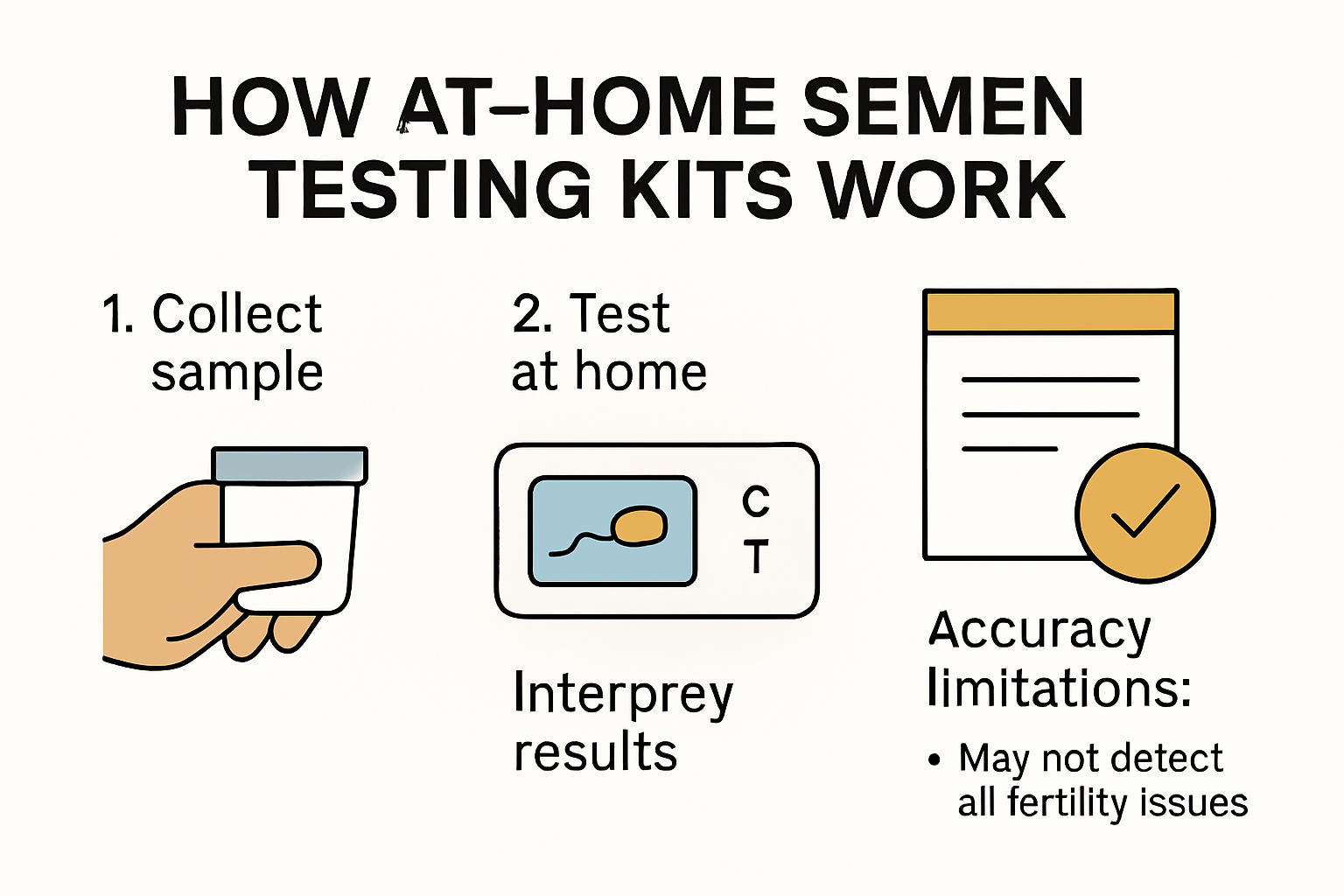Semen testing kits have taken privacy and convenience to a new level, allowing men to check their reproductive health without stepping into a clinic. Here is something most people miss. Recent data shows mail-in semen tests are now just as reliable as traditional clinic tests for confirming vasectomy success and predicting fertility. Instead of relying only on lab visits, more men are turning to at-home kits for quick answers. What really sets these kits apart is not only their accuracy but the details users need to watch for, from sample timing to strict handling steps. There is a lot more to this simple device than meets the eye.
Table of Contents
- What Are Semen Testing Kits And How Do They Work?
- Choosing The Right Kit For Vasectomy Confirmation
- Using Semen Testing Kits When Trying To Conceive
- Common Mistakes And How To Get Accurate Results
Quick Summary
| Takeaway | Explanation |
|---|---|
| Convenience of Semen Testing Kits | Semen testing kits provide a discreet and accessible way for men to evaluate their reproductive health at home, suitable for confirming vasectomy success or assessing fertility concerns. |
| Key Considerations for Vasectomy Kits | Choose FDA-cleared and CLIA-certified kits that deliver accurate results, provide comprehensive reporting, and ensure privacy during the testing process. |
| Understanding Test Limitations | While home semen kits offer preliminary insights into sperm concentration and motility, they do not replace professional medical evaluations for a complete understanding of reproductive health. |
| Importance of Proper Sample Handling | Accurate results depend on following strict sample collection protocols to avoid timing and handling errors, including temperature control and contamination prevention. |
| Interpreting Results with Caution | It is crucial to consult with healthcare providers for result interpretation and consider multiple tests for confirmation, as home tests provide initial insights but not definitive diagnoses. |
What Are Semen Testing Kits and How Do They Work?
Semen testing kits are specialized diagnostic tools designed to help men assess their reproductive health with privacy and convenience. These innovative at-home solutions enable individuals to analyze key aspects of their semen quality without the traditional need for clinical visits. Whether you’re confirming the success of a vasectomy or exploring potential fertility concerns, understanding how these kits function can empower you to take proactive steps in your reproductive health journey.
The Science Behind Home Semen Analysis
At their core, semen testing kits are precision instruments that evaluate critical parameters of male reproductive potential. Unlike traditional laboratory tests, these kits provide a streamlined approach to initial fertility assessment. According to Cleveland Clinic, at-home tests can offer valuable preliminary insights, though they do not replace comprehensive clinical evaluations.
Typically, these kits analyze sperm concentration by detecting the presence and quantity of sperm in a semen sample. The process involves collecting a sample through a provided sterile collection method, such as a specialized condom or collection cup. Once collected, users apply the sample to a testing device that uses advanced microfluidic technology or chemical indicators to assess sperm count.

Functional Mechanics of Semen Testing Kits
The operational process of semen testing kits follows a structured approach. SpermCheck explains that most kits work by comparing the semen sample against predetermined thresholds. For post-vasectomy confirmation, this often means determining whether sperm count is below 250,000 sperm per milliliter - the benchmark for successful sterilization.
Most kits include several critical components to ensure accurate testing:
- Collection Device: A non-latex collection method that allows for hygienic sample gathering
- Transport Tube: A specialized container with preservative solution to maintain sample integrity
- Testing Strip or Cassette: The diagnostic component that analyzes sperm concentration
- Detailed Instructions: Step-by-step guidance to ensure proper sample collection and testing
Users typically follow a precise protocol: collect the sample, wait a specified duration, apply the sample to the testing device, and then interpret the results based on the appearance of test lines or digital readout. Jack At Home’s detailed kit instructions provide comprehensive guidance for accurate home testing.
While these kits offer remarkable convenience, it is crucial to understand their limitations. They primarily assess sperm quantity and cannot comprehensively evaluate other critical fertility factors like sperm motility or morphology. For a complete fertility assessment, consulting a healthcare professional remains essential.
The evolution of semen testing technology represents a significant advancement in men’s reproductive health management. By providing accessible, private, and rapid testing options, these kits empower individuals to take an active role in understanding their reproductive capabilities. Whether you’re seeking post-vasectomy confirmation or exploring fertility potential, home semen testing kits offer a modern, discreet solution to initial reproductive health screening.

Choosing the Right Kit for Vasectomy Confirmation
Selecting the appropriate semen testing kit for vasectomy confirmation is a critical step in ensuring accurate reproductive health verification. The process requires careful consideration of several key factors to guarantee reliable results and peace of mind. Understanding the nuanced differences between available testing options can help men make informed decisions about their post-vasectomy assessment.
Key Considerations for Vasectomy Confirmation Kits
Not all semen testing kits are created equal, especially when it comes to post-vasectomy verification. According to PVSA research, a comprehensive post-vasectomy semen analysis requires precise testing methods. The primary goal is to confirm the complete absence of sperm, which typically means having fewer than 250,000 sperm per milliliter.
When evaluating potential testing kits, men should focus on several critical aspects:
- Certification: Choose kits from FDA-cleared providers with proven reliability
- Laboratory Accuracy: Ensure the kit uses CLIA-certified laboratory analysis
- Comprehensive Reporting: Look for detailed results that provide clear interpretation
- Privacy: Select kits that offer discreet packaging and secure result reporting
Understanding Kit Capabilities and Limitations
A 2022 analysis of 5,408 post-vasectomy specimens revealed that most men can successfully complete their confirmation through mail-in testing. Jack At Home’s guide to vasectomy confirmation highlights the importance of understanding each kit’s specific capabilities.
Most high-quality vasectomy confirmation kits include:
- Sterile collection materials
- Preservation solution
- Pre-paid shipping container
- Detailed instructions
- Secure online results reporting
It is crucial to recognize that while at-home testing provides significant convenience, it does not replace professional medical advice. Some urologists recommend multiple tests over several months to ensure consistent sterility.
The technological advancements in home testing have transformed vasectomy confirmation from a cumbersome clinical process to a private, straightforward experience. Men can now confidently verify their reproductive status without multiple uncomfortable clinic visits. By carefully selecting a reputable testing kit and following instructions precisely, individuals can obtain accurate results with minimal stress.
Ultimately, the right vasectomy confirmation kit combines scientific accuracy, user-friendly design, and comprehensive reporting. Consulting with a healthcare provider and thoroughly researching available options will help ensure the most reliable testing experience.
Using Semen Testing Kits When Trying to Conceive
For couples navigating the complex journey of conception, understanding male fertility becomes a critical component of reproductive planning. Semen testing kits offer a modern, accessible approach to gaining insights into reproductive potential, empowering individuals with preliminary information about their reproductive health before seeking extensive medical intervention.
Understanding Fertility Assessment Through Home Testing
The global sperm count test market reflects a growing recognition of at-home fertility assessment tools. According to market research, the market is projected to reach USD 2.47 billion by 2025, highlighting the increasing demand for convenient and private fertility testing solutions.
Home semen testing kits provide couples with initial insights into male reproductive health by evaluating key parameters such as sperm concentration and basic motility. Comprehensive fertility planning involves understanding these fundamental metrics that contribute to successful conception.
Interpreting Semen Testing Results
Research from the University of Southern California indicates that mail-in sperm testing systems can be just as reliable as clinical tests in predicting male fertility. However, it is crucial to understand the limitations of these at-home tests.
Typical home semen testing kits evaluate several critical factors:
- Sperm Concentration: Measuring the number of sperm per milliliter
- Basic Motility: Assessing the percentage of moving sperm
- Preliminary Health Indicators: Providing initial reproductive health insights
While these kits offer valuable preliminary information, they do not replace comprehensive medical fertility assessments. Couples experiencing persistent conception challenges should consult reproductive health specialists for more detailed evaluations.
The emergence of artificial intelligence and digital health technologies is transforming at-home fertility testing. Sperm function tests now integrate advanced algorithms to provide more nuanced insights into male reproductive potential.
Navigating fertility challenges requires a holistic approach. Semen testing kits represent an important first step in understanding reproductive health, offering privacy, convenience, and initial insights. They empower individuals to take proactive measures in their fertility journey, bridging the gap between personal health awareness and professional medical consultation.
Remember that fertility is a complex interplay of multiple factors. While these kits provide valuable initial information, they should be viewed as a complementary tool in a broader reproductive health strategy. Open communication, lifestyle considerations, and professional medical guidance remain essential components of successful family planning.
Common Mistakes and How to Get Accurate Results
Accurate semen testing requires precision, attention to detail, and a thorough understanding of potential pitfalls that can compromise result reliability. Men using at-home testing kits must navigate several critical factors to ensure their reproductive health assessment provides meaningful insights.
Timing and Sample Collection Errors
One of the most significant challenges in semen testing involves proper sample collection. According to PVSA research, incorrect timing and handling can dramatically impact test accuracy. Jack At Home’s testing guide emphasizes the importance of following collection protocols precisely.
Common timing-related mistakes include:
- Premature Testing: Collecting samples too soon after a vasectomy
- Insufficient Waiting Period: Not allowing enough ejaculations to clear remaining sperm
- Improper Abstinence: Not following recommended sexual activity guidelines before sample collection
Technical Handling and Preservation Challenges
Precision in sample handling can make or break test accuracy. Scientific research indicates that at-home tests like SpermCheck can achieve up to 96% accuracy when users meticulously follow instructions. Critical technical considerations include:
- Temperature Sensitivity: Protecting the sample from extreme temperatures
- Contamination Prevention: Using sterile collection methods
- Timely Processing: Shipping the sample within recommended timeframes
A clinical trial demonstrated that 96% of patients found professional-grade preservation kits straightforward to use, highlighting the importance of user-friendly design in maintaining sample integrity.
Interpreting Results and Next Steps
Misinterpreting test results is a common pitfall that can lead to unnecessary anxiety or false conclusions. Sperm function tests recommend a nuanced approach to result interpretation.
Key recommendations for accurate result management:
- Multiple Testing: Consider conducting more than one test for confirmation
- Professional Consultation: Always discuss results with a healthcare provider
- Comprehensive Assessment: Recognize that home tests provide initial insights, not definitive diagnoses
Navigating the complexities of semen testing requires a combination of careful technique, patience, and professional guidance. While at-home kits offer unprecedented convenience, they are most effective when used as part of a comprehensive reproductive health strategy.
Remember that individual variations in fertility and reproductive health mean no single test can provide a complete picture. Approach semen testing as one tool in understanding your reproductive potential, always complementing home results with professional medical advice and comprehensive health assessments.
Frequently Asked Questions
What are semen testing kits and how do they work?
Semen testing kits are at-home diagnostic tools designed to help men assess their reproductive health by analyzing key parameters of their semen quality. Users collect a semen sample using a sterile method, apply it to a testing device, and receive results on sperm concentration and motility.
How accurate are home semen testing kits for confirming vasectomy success?
Home semen testing kits, when properly used, can be just as reliable as traditional clinical tests for confirming vasectomy success. They typically determine whether sperm count is below 250,000 sperm per milliliter, the standard benchmark for successful sterilization.
What should I consider when choosing a semen testing kit for fertility?
When selecting a semen testing kit for fertility assessment, look for FDA-cleared and CLIA-certified options. Ensure the kit provides comprehensive reporting, has a user-friendly design, and maintains privacy throughout the testing process.
How do I interpret the results from a semen testing kit?
Interpreting results from a semen testing kit involves understanding key metrics such as sperm concentration and motility. It’s essential to consult with a healthcare provider for professional interpretation and consider conducting multiple tests to confirm findings.





